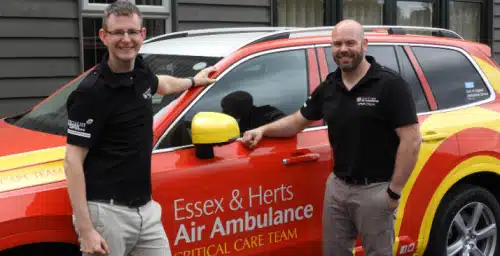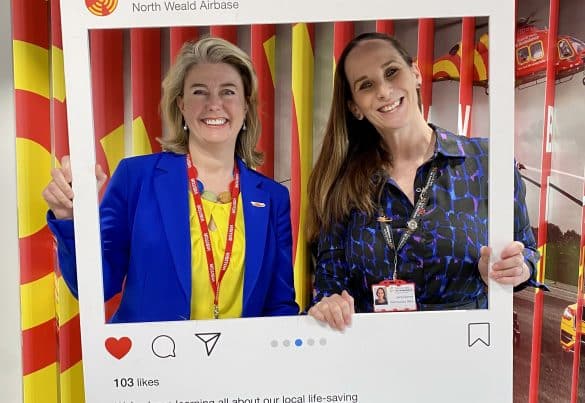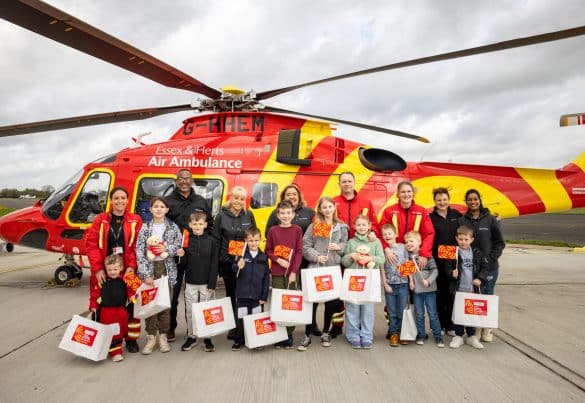NHS London Nightingale – Tony Stone and Adam Carr
SHARE

NHS London Nightingale – Tony Stone and Adam Carr
When the COVID-19 lockdown meant that EHAAT’s Patient Liaison Managers Tony Stone and Adam Carr couldn’t visit airlifted patients in hospital or organise airbase visits, they stepped forward to assist at the temporary London NHS Nightingale hospital.
Constructed inside the huge London ExCel Centre, the Nightingale had the capacity to cope with thousands of patients.
Adam Carr. We were contacted by Frank Chege, who is the Patient Liaison Nurse at London’s Air Ambulance. He’d been asked to set up a family support and liaison team at the Nightingale to be the point of contact between patients and their next of kin. It was headed up by Gareth Grier from The Royal London Hospital, who is one of EHAAT’s on-call consultants. The other members of the team had been seconded from their roles in the NHS. We did two shifts a week so that we could still cover our clinical shifts with EHAAT.
Tony Stone. We realised that we really wanted to be involved in this project. We had skills from EHAAT that would allow us to communicate with families, we were familiar with wearing Personal Protective Equipment (PPE), which was part of the role, used to difficult conversations and so on. Because we couldn’t do hospital visits or host base visits, we had some capacity and we were both keen to do our bit.
When we arrived on the first day to start work it was a bit of a building site, and it was still being built for the duration of our time there. We’d both seen it on the news, but the first time we were standing there, there was definitely a moment that we realised how huge this was going to be. It really drove home just how seriously they were taking it.
Adam: I remember thinking what it would look like when it was full of patients and staff. It was a real moment of clarity. It was a big unknown for both of us, both with what was going to happen with COVID19 and the unfamiliarity of working in that environment.
Tony. Frank and Gareth both gave talks on that first day and it was clear how difficult it was going to be for the families. They weren’t going to be able to visit their loved ones routinely, and might not have seen them in whichever hospital they’d been previously for many weeks.
Every patient’s family got an update call once every 24 hours, regardless of their status. If there was a significant deterioration, they would get another call but if they were on maximum care and it was judged that they were likely to die, their family would be offered a visit.
Adam. On the first day governance and procedures had to be put in place. Tony mapped out a flow chart for all the information we would be gathering and the procedures for making calls. My task was to map out the logistics of getting a family into the hospital. That included the information they would need beforehand on where to come to their route in and out of the hospital. From getting out of their car, they’d go to a relatives’ room where we would discuss what was going to happen. Then we would get them into PPE and through with one of the team to see their relative.
Tony. Even the calls to families of people who were relatively stable could still be quite challenging. Families were frightened and wanted to know what was happening so we had a real mix of responses. We are used to dealing with people, having difficult conversations, but doing it over the phone was less familiar.
I was humbled listening to people who were going through a very difficult time. Their loved ones were being treated in an intensive care unit set up in an exhibition centre on the side of the Thames. Families were so kind, thanking us for what we were doing, but I can only imagine what they were going through and what life was like for them.
Adam. Two calls stand out for me. One of the things we would do was get messages from the family to be read out to the patient. One I had was from an elderly lady who wanted to say to her husband that he needed to get home soon as she couldn’t watch Gogglebox without him!
Another was a household where a lad of nine was with his mum and three sisters. He wanted to speak to a male figure because his dad was in the hospital. In his words, he needed me `to agree with him’, so that’s what I did during quite a long call with his phone on loudspeaker.
It was nice to be part of a team of 8 to 10 people each with a mix of backgrounds, including specialist nurses in organ donations, and volunteers from the First Aid Nursing Yeomanry, who normally man the phones at times of major mass casualty incidents.
Tony. Looking back, it was great to learn new things, it was a very dynamic environment, and nice to be part of the team each day. We also learned a lot about the treatments that take place in an intensive care unit, which is something that we don’t usually see.
Adam. The big thing about the Nightingale for me is how helpful everyone was. Every member of staff who worked there, from security, to the cleaners, to the consultants was approachable and did what was asked of them. Everyone had a `we can’ attitude, nothing was too much trouble for anyone. If people identified a problem they would just crack on and find a resolution. If you asked for something to be done, it was done as quick as anyone could do it. It really was very impressive.
Tony. We’d both like to thank everyone at EHAAT, but in particular our CEO Jane Gurney and Clinical Director Stuart Elms for giving us so much support. We learned a lot from the experience. We’d also like to thank Frank Chege and Gareth Grier for giving us the opportunity.

#YourLocalLifeSavingCharity
Join our mailing list
Join the community and recieve all the latest news and updates straight to your inbox.






